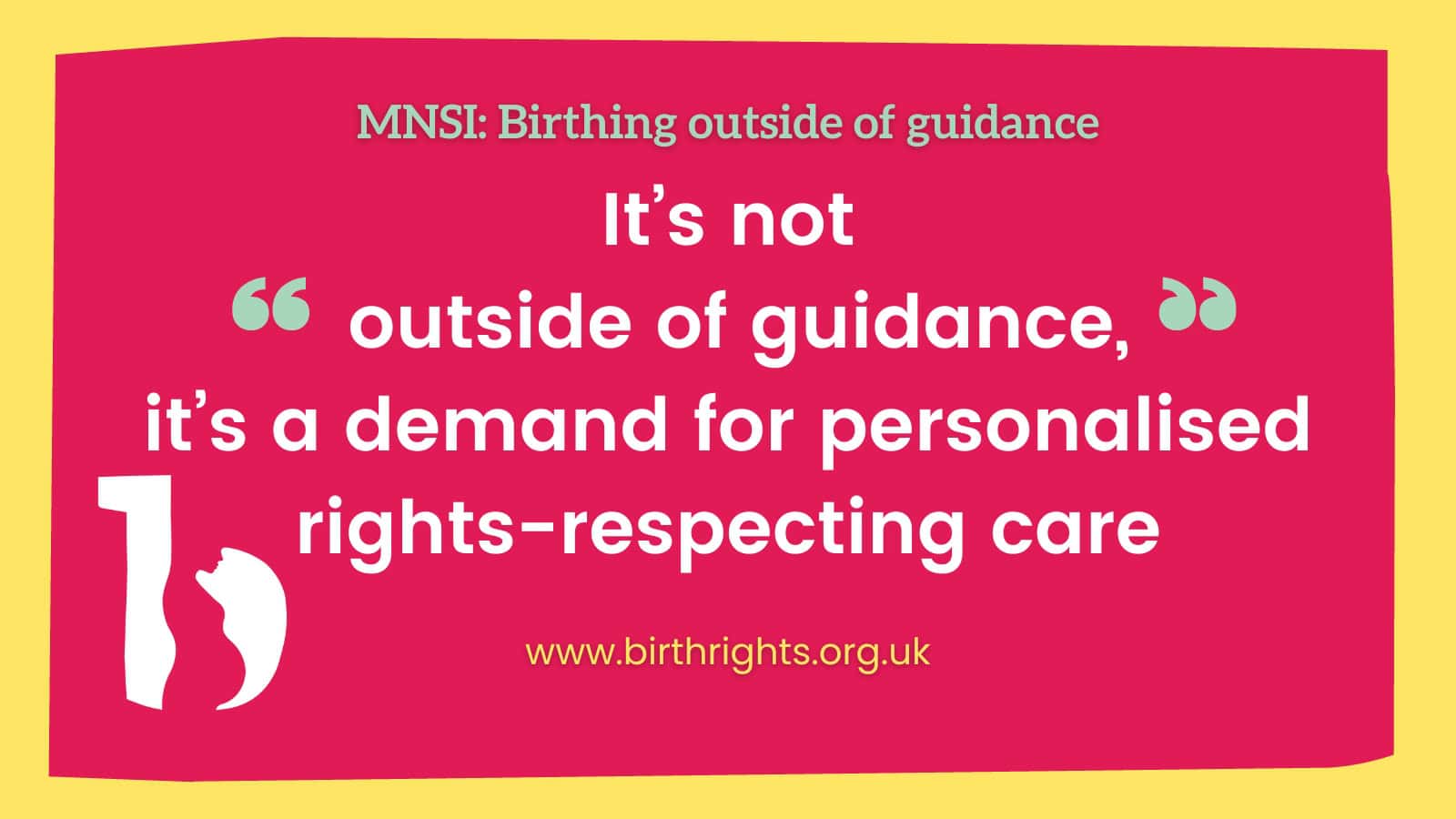
Is it “outside of guidance”, or is it a demand for personalised rights-respecting care?
This statement is a response to the MNSI’s recently published briefing on Birthing Outside of Guidance and to a wider and worrying trend of stigmatizing personalised choices as “out of guidance”.
What is “outside of guidance”?
A term used by some Trusts and NHS bodies to describe situations when pregnant women and birthing people make decisions that are different from those recommended in, or envisaged by, local or national maternity care guidelines.
In reality, “outside of guidance” frequently reflects a request for personalised care that responds to the individual needs and circumstances of women and birthing people.
What should the priority be?
Birthrights firmly believes that, rather than fixating on “out of guidance” scenarios, the priority across maternity services should be to ensure that personalised care and informed decision-making are embedded as standard practice for all, in line with the human rights-based framework.
Personalised care—care that recognises each individual’s experiences and needs—is not optional; nor does it only apply in “out of guidance” scenarios. It is a fundamental human right and not supporting this exposes Trusts to legal liability. Upholding this right, and supporting women and birthing people to make informed choices about their bodies and their care, is essential to delivering truly safe and respectful maternity care.
We are concerned about the potential for the MNSI briefing and its “safety prompts” to be misinterpreted or misapplied in a manner that undermines human rights in maternity care. It is important to recognise that the MNSI briefing does not exist in isolation. Rather, it forms part of a wider and deeply concerning trend of producing guidance for so-called “out of guidance” scenarios. We are particularly concerned that Trusts may adopt this document as a template, with far-reaching implications. Specifically, there is a real risk that, in adhering to the briefing and its “safety prompts”, healthcare professionals will face increased barriers to providing truly rights-respecting, personalised care.
We strongly recommend an explanatory note to clarify the document’s intent and to safeguard against restrictive interpretations. In the absence of an explanatory note issued by MNSI, we share below our own note and additional safety prompts, for any Trusts, hospitals and healthcare professionals considering the MNSI briefing.
- “Outside of guidance” is a term used by some Trusts and NHS bodies to describe situations when pregnant women and birthing people make decisions that are different from those recommended in, or envisaged by, local or national maternity care guidelines. It is important to note that “outside of guidance” does not necessarily equate to “higher risk” in every individual instance, and that what constitutes “outside of guidance” in one trust or hospital may be recommended practice in another.
- The law requires that healthcare professionals support all pregnant women and birthing people to make their own informed decisions about their care, by offering to provide information about the material risks and benefits of the clinically recommended treatment/care option, as well as the material risks and benefits of all reasonable alternative options. The information should be provided in language the woman or birthing person can understand, it should be personalized to their particular circumstances, and it should be provided free from judgement, bias and pressure. These legal requirements on healthcare professionals are not different depending on whether or not the pregnant woman or birthing person is considering making an “outside of guidance” choice.
- Given the focus of this briefing, most of the safety prompts refer to “outside of guidance” scenarios. Nonetheless, in order to ensure legal compliance, it will be important to ensure that any actions taken in response to these safety prompts do not suggest or imply that choice conversations are more important/necessary where women and birthing people may make “out of guidance” choices (as compared with circumstances where women and birthing people may be expected to make “in guidance” choices).
- Equally, care will need be taken to ensure that any processes developed to respond to these safety prompts do not:
- 1. stigmatise women or birthing people who make non-normative choices; or
- 2. result in pressure being expressly or impliedly being put on women and birthing people to make different choices (e.g. by mandating that choice conversations be repeated several times with women and birthing people making “out of guidance” choices, in circumstances where these would not be required to be repeated had that person made an “in guidance” choice).
| Original safety prompt (MNSI Briefing page 3) | Birthrights additional prompt |
| Do you have a guideline or process to support staff and mothers / birthing people when care choices are outside of national or local guidance? | Also consider: (a) Do you have a guideline or process to support staff in how to have effective, personalised choice conversations with all women and birthing people, in order to facilitate informed decision making? This guideline or process should apply to all choice conversations, and should not be limited to use in “outside of guidance” cases. (b) Do you have a process to support staff when they are providing care “outside of guidance”, recognising that departing from clinical guidance may result in feelings of discomfort or vulnerability in some staff? In order for women and birthing people to have their decisions respected and supported, supporting staff with both aspects (1) and (2) is key. |
| Is there any training available for staff in how to navigate conversations in order to facilitate supported decision making? | This training should be useful for all choice conversations, and should not be specific to “outside of guidance” scenarios. |
| Can women / birthing people benefit from birth choice clinics that are multi-professional and use supported decision-making principles? | Birth choice clinics may be useful in many different scenarios, and their use should not be limited to “outside of guidance” circumstances. Equally, choice conversations should not only be happening in birth choice clinics – all maternity staff should be trained in, and regularly having, these conversations in all settings, including where women and birthing people are making “out of guidance” choices. |
| When a woman / birthing person requests a birth plan that deviates from national or local guidance, is this agreed in advance of birth? Do discussions include contingencies so there are clear parameters for acceptable care pathways when the situation changes, or an emergency occurs? | Antenatal discussions about birth plans, and the circumstances in which women and birthing people may be happy to deviate from them, will be useful in almost all cases, and such discussions should not only occur where a woman or birthing person is making an “outside of guidance” choice. |
| Are there resources (leaflets/videos/infographics) available that include up to date information, that are easily accessible and clear, to assist mothers / birthing people in supported decision-making when seeking care outside of national or local guidance? | Resources for women and birthing people should never be used an alternative to choice conversations; at most they are a supplement. Resources should also be available to support staff to easily access the information they need to facilitate effective choice conversations. |
| Have you considered exploring with families their reasons for choosing to birth outside of guidance to enable learning? | Taking an open-minded and interested approach from the outset is necessary to facilitate effective, personalised choice conversations. |
If you are concerned about the maternity care you are receiving and believe your rights are not being respected, you can learn more about your rights from our human rights factsheets via the button below. If you need more support or have a question not answered by our factsheets, you can contact Birthrights’ advice and information team.
Know your rights: our human rights factsheets
